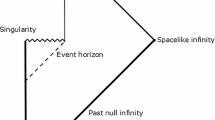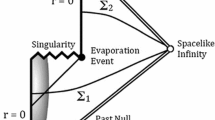Abstract
The information loss paradox is often presented as an unavoidable consequence of well-established physics. However, in order for a genuine paradox to ensue, not-trivial assumptions about, e.g., quantum effects on spacetime, are necessary. In this work we will be explicit about these additional, speculative assumptions required. We will also sketch a map of the available routes to tackle the issue, highlighting the, often overlooked, commitments demanded of each alternative. Finally, we will display the strong link between black holes, the issue of information loss and the measurement problem.



Similar content being viewed by others
Notes
A Cauchy hypersurface is a subset of spacetime which is intersected exactly once by every inextensible, non-spacelike curve.
Future null infinity is the set of points which are approached asymptotically by null rays which can escape to infinity.
This is a process, studied in [21], by which a rotating black hole can convert some of its “rotation energy” into kinetic energy.
The ADM mass is a quantity associated with the asymptotic behavior of the induced spatial metric of a Cauchy hypersurface. In asymptotically flat spacetimes, it is known to be independent of the hypersurface on which it is evaluated (see [2]).
Note however that the argument can be easily reversed to show exactly the opposite. Since Hawking’s result shows that unitarity breaks when black holes are present, one must conclude that quantum evolution cannot be unitary even in a quantum field theory on flat spacetimes.
References
Almheiri, A., Marolf, D., Polchinski, J., Sully, J.: Black holes: complementarity or firewalls? JHEP 62, (2013)
Deser, S., Misner, C.: The dynamics of general relativity. In: Witten, L. (ed.) Gravitation: an Introduction to Current Research. Wiley, New York (1962)
Ashtekar, A., Bojowald, M.: Black hole evaporation: a paradigm. Class. Quant. Grav. 22(16), 3349 (2005)
Banks, T.: Lectures on black hole information loss. Nucl. Phys. Proc. 41(1), 21–65 (1994)
Banks, T., Susskind, L., Preskin, M.E.: Difficulties for the evolution of pure states unto mixed states. Nucl. Phys. B 244(1), 125–134 (1984)
D. Bedingham, S.K. Modak, D. Sudarsky.: Relativistic collapse dynamics and black hole information loss. arXiv:1604.06537 (2016)
Bekenstein, J.D.: Black holes and the second law. Lett. Nuovo Cim. 4(15), 737–740 (1972)
Ghirardi, G.C., Rimini, A., Weber, T.: Unified dynamics for microscopic and macroscopic systems. Phys. Rev. D 34, 470–491 (1986)
Hawking, S.W.: Breakdown of predictability in gravitational collapse. Phys. Rev. D 14(10), 2460 (1976)
Hawking, S.W., Ellis, G.F.R.: The Large Scale Structure of Spacetime. Cambridge University Press, Cambridge (1973)
Hotta, M., Schützhold, R., Unruh, W.G.: On the partner particles for moving mirror radiation and black hole evaporation. arXiv:1503.06109 (2015)
Maldacena, J., Susskind, L.: Cool horizons for entangled black holes. arXiv:1306.0533 (2013)
Mathur, S.D.: The fuzzball proposal for black holes: an elementary review. Fortsch. Phys. 53, 793–827 (2005)
Maudlin, T.: Three measurement problems. Topoi 14(1), 7–15 (1995)
Modak, S.K., Ortíz, L., Peña, I., Sudarsky, D.: Non-paradoxical loss of information in black hole evaporation in a quantum collapse model. Phys. Rev. D 91, 124009 (2015)
Okon, E., Sudarsky, D.: Benefits of objective collapse models for cosmology and quantum gravity. Found. Phys. 44, 114–143 (2014)
Okon, E., Sudarsky, D.: The black hole information paradox and the collapse of the wave function. Found. Phys. 44, 461–470 (2015)
Pearle, P.: Combining stochastic dynamical state vector reduction with spontaneous localization. Phys. Rev. A 39, 2277–2289 (1989)
Penrose, R.: Time asymmetry and quantum gravity. In: Isham, C.J., Penrose, R., Sciama, D.W. (eds.) Quantum Gravity II. Clarendon Press, New York (1981)
Penrose, R.: The Emperor’s New Mind: concerning Computers, Minds, and the Laws of Physics. Oxford University Press, Oxford (1999)
Penrose, R., Floyd, R.M.: Extraction of rotational energy from a black hole. Nat. Phys. Sci. 229(6), 177–179 (1971)
Perez, A:. Private communication (2016)
Strominger, A.: The ads/cft correspondence. JHEP 77, 106009 (2001)
Susskind, L.: String theory and the principle of black hole complementarity. Phys. Rev. Lett. 71, 2367–2368 (1993)
Susskind, L.: The world as a hologram. J. Math. Phys. 36, 6377 (1995)
Susskind, L., Thorlacius, L., Uglum, J.: The stretched horizon and black hole complementarity. Phys. Rev. D 48, 3743–3761 (1993)
Unruh, W.G., Wald, R.M.: On evolution laws taking pure states to mixed states in quantum field theory. Phys. Rev. D 52, 2176–2182 (1995)
Wald, R.M.: Quantum Field Theory in Curved Spacetime and Black Hole Thermodynamics. University of Chicago Press, Chicago (1994)
Acknowledgements
We acknowledge partial financial support from DGAPA-UNAM Project IG100316. DS was further supported by CONACyT Project 101712.
Author information
Authors and Affiliations
Corresponding author
Rights and permissions
About this article
Cite this article
Okon, E., Sudarsky, D. Black Holes, Information Loss and the Measurement Problem. Found Phys 47, 120–131 (2017). https://doi.org/10.1007/s10701-016-0048-1
Received:
Accepted:
Published:
Issue Date:
DOI: https://doi.org/10.1007/s10701-016-0048-1




